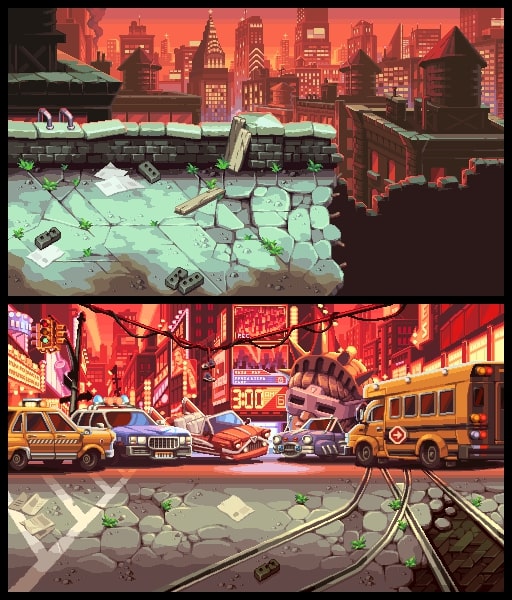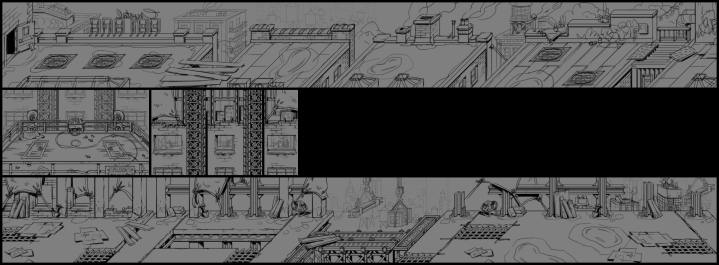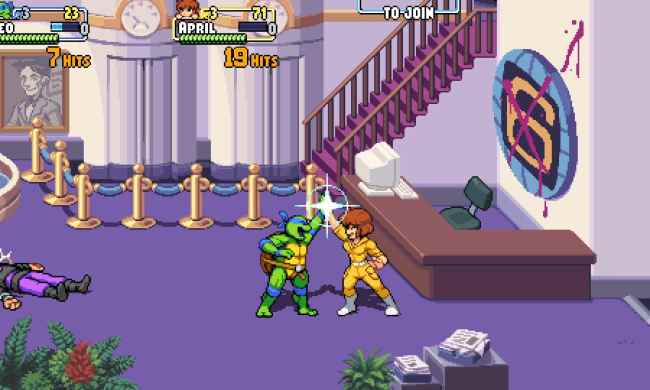
When it comes to the Teenage Mutant Ninja Turtles, there are two things that define the heroes: Pizza and New York City.
Since the franchise’s creation in 1984, NYC has been a core part of the turtles’ ethos. It’s not just an empty backdrop for superhero antics, but a city that reflects their entire being. Its streets and sewers become an urban playground for the four brothers. Like any good New Yorker, the turtles feel a deep sense of pride for their home, swearing to protect even its ugliest corners.
For Teenage Mutant Ninja Turtles: Shredder’s Revenge, a new beat-’em-up game inspired by arcade classics available today, there was never any question about where it would be set. From the jump, the developers at Tribute Games wanted to make sure NYC was one of the game’s main characters, right alongside the turtles themselves.
Ahead of the game’s surprise launch, I sat down with the Tribute Games team to discuss their approach to turning NYC into a side-scrolling paradise. To really nail the setting, the team would have to separate two locations: The real-world city and the Turtles’ version of it. Those may sound similar, but there are some key differences between them.
Tour guide
From the jump, Tribute Games always knew New York City would be its focus. The game was conceived as a sort of “tour guide” of NYC, which you can immediately see when looking at its Manhattan-based overworld screen. While previous turtles games have taken the brothers all over the place (past and future), game designer Frederic Gemus noted that they wanted to stick to the series’ roots.
“Most of the action in the cartoons occurs in New York City at the street level, so that’s what we wanted to do from the start,” Gemus tells Digital Trends. “But we wanted to stick to the cartoon version. In the cartoon version, anything can happen, because New York is such a complex city with varied environments … It would make sense to have all these crazy things happening all over the city, because it’s New York!”

Living primarily in that cartoon version of New York would help Tribute Games bend reality to its design needs (“our version has less traffic,” Gemus jokes). For instance, the team wanted to have a level set in a mall, but NYC doesn’t exactly have a notable one to draw from. The Turtles cartoon, however, has an episode set in the fictional Crystal Palace Mall, which solved that problem. Art director Julian Adam Marin notes that while the Turtles franchise has a sincere reverence for NYC, it also depicts the city in more universal terms, something that’s baked into cartoon language.
“In TMNT, when NYC needs to be NYC, it is NYC. And sometimes it’s just a city,” Marin tells Digital Trends. “Sometimes it represents whatever city you’re familiar with. Sometimes Central Park is just a park. Finding the ways things boil down to the cartoon version of what it is, that becomes the visual language of Saturday morning cartooning and the DNA of the series.”
’80s Manhattan
While the game draws heavy inspiration from the fictionalized version of the city, especially from the cartoon continuity, it’s still grounded in reality. In between fictional Turtles locations like the Channel Six News station, the team fights its way through iconic Manhattan spots like the Central Park Zoo, Coney Island, and more.

The Tribute Games team isn’t based in New York, and since development for the game began in 2020, the amount of in-person scouting it could do was limited. They couldn’t just pop into a hole-in-the-wall dollar pizza place and throw back a greasy slice for research purposes (or otherwise). But Marin notes that those limitations were more helpful than they were hurtful.
“When it came to researching New York, a lot of it had to do with getting ourselves in the time period that the vision of New York was conceived of at the time TMNT was created,” Marin says. “It’s one thing to visit the city in 2020, but it would have been very different than being able to look through photography and video of New York in the late 1980s … We’re seeing things that feel familiar, but from a different vantage point. You’re seeing things that were just behind what you saw in the TV show, if you just panned the camera a little to the right.”

That’s ultimately the vibe the level design nails. Its version of NYC more closely resembles what it looked like in the ’80s. There’s more attitude to its subways and streets, which are tagged up with graffiti. Though it might look gruff, especially compared to the overly commercialized Manhattan of 2022, the team didn’t want to depict it in stereotypically gritty terms. Instead, the developers wanted to celebrate that version of New York by drilling down on what that more human vision of the city meant.
“Our version of NYC focuses on the welcoming aspect of the city,” Marin says. “And I think these are a lot of people’s experiences of the city. The part of the city that people who live there really love about it is that you can be yourself and that there’s a lot of different people there.”
Here I am
In trying to create a cartoony, but still somewhat grounded spin on New York, Tribute Games took an almost philosophical approach to design. The concept of self-expression came up several times during our chat, as Tribute Games wanted to use the location to put an emphasis on youth culture — something that’s easy to forget when making a cartoon about radioactive turtles.
“It’s not just about the places and the environment, but also the character of New York City and the attitude,” Marin says. “I think it’s easy enough to think about TMNT and think ‘they’re mutants, they’re ninjas,’ but we forget about the teenage quality. Teenagers exist in urban environments and have a unique relationship to those. The kind of teenage rebelliousness, the culture of graffiti tagging — the way that people make their mark on their environments, especially in New York City as a melting pot — that’s also part of the attitude of TMNT.”

Street art isn’t just set dressing in Shredder’s Revenge. For one, it’s the game’s clever way of telling a story through environmental storytelling (pay close attention to who’s tagging what), something that sets it apart from the arcade classics. But more fundamentally, Marin sees graffiti as the key symbol that ties both the fictional world of the turtles and the very real city together.
“There was a point in time where seeing graffiti on the wall had a very negative association with it,” Marin says. “But to me it’s a celebratory aspect of ownership in the city and a way that people can show that they’re present and can express themselves. And the fact that we can combine that attitude of saying ‘here I am,’ which has always been part of TMNT … I think that’s the way our NYC is really differentiated from the way we’ve done cities in the past.”

It’s those little decisions that ultimately give the setting an air of authenticity, rather than making it feel like a tourist trip. While Tribute Games hits all the important landmarks that most actual New Yorkers avoid like the plague, it makes sure to pay attention to the details that really speak to the city’s character. Some are loudly symbolic, like the Statue of Liberty, which serves as a symbol of unity in the Turtles’ general design language. Others are tiny, like the stone chess tables that line its version of Central Park. The developers don’t see a difference between those two ends of the spectrum. They’re all important colors in the same landscape painting.
“It’s easy on the art side to get really excited about the flashy stuff. The mundane doesn’t really have to be boring,” Marin says.
Teenage Mutant Ninja Turtles: Shredder’s Revenge is out now on PS4, PS5, Xbox One, Xbox Series X/S, PC, and Nintendo Switch.



